Oman is a country with many surprises and unique experiences to be had, if you know where to look!
From the desert to the sea, and everything in between. Here, I’ve listed the highlights and what you must visit during your Oman tour or road trip.
I took this route myself and tested out the logistics for a seamless road trip of around 14 days in Oman. Here is your perfect 2 week itinerary in Oman!
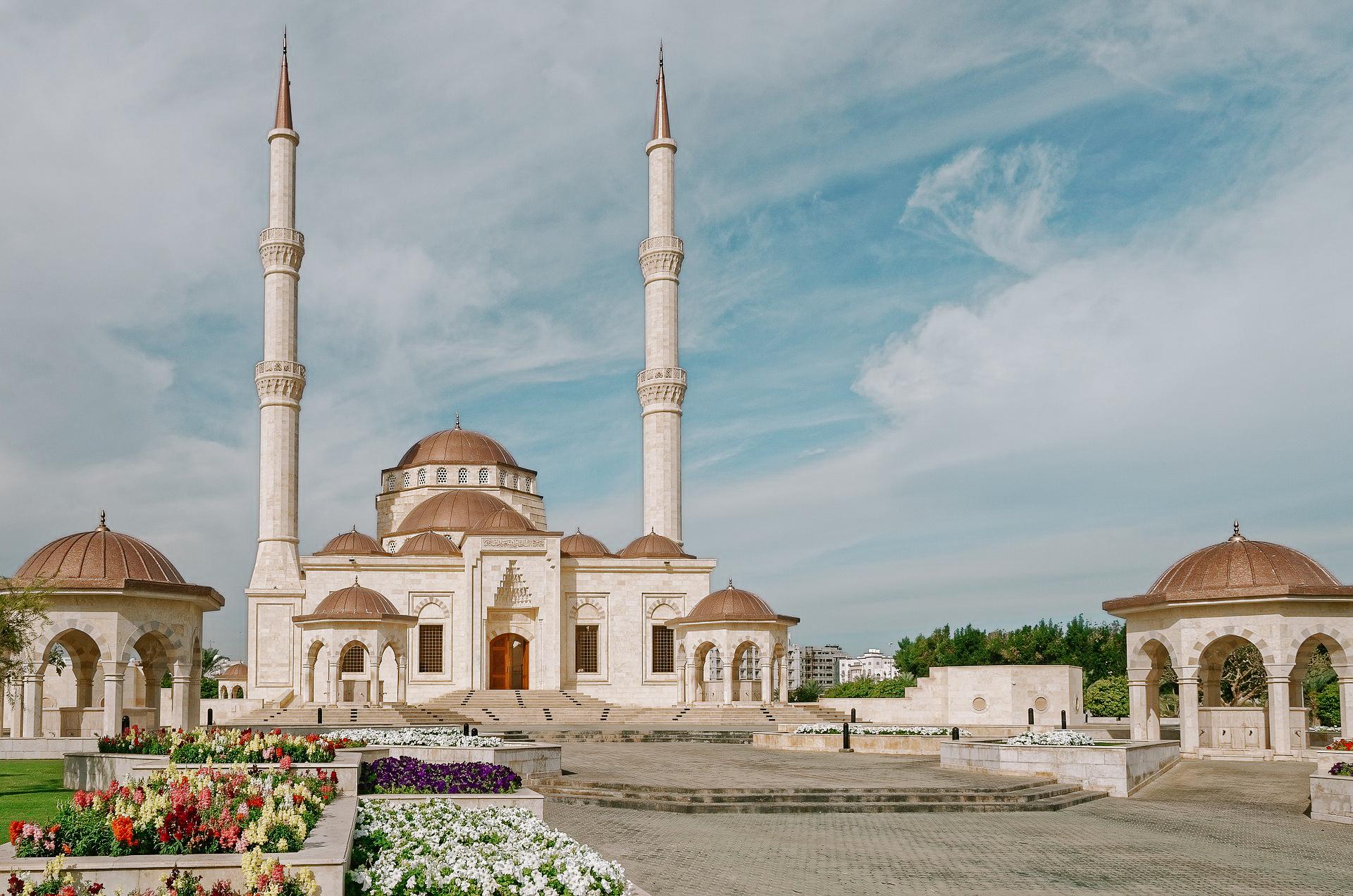
Best Month to Visit Oman
Oman is known as being an unbearably hot country most of the year. This becomes extremely true in summer, when temperatures regularly reach 38 degrees Celsius and beyond.
If you want to visit in summer, the upside is that you can visit the mystical waterfalls of Selalah which only form in summer.
For the coolest temperatures in Oman, opt to visit in winter instead. I visited in December, and can report comfortable day time temperatures of around 25 degrees Celsius. It never got too hot, but it was warm enough to enjoy the beach and swimming holes.
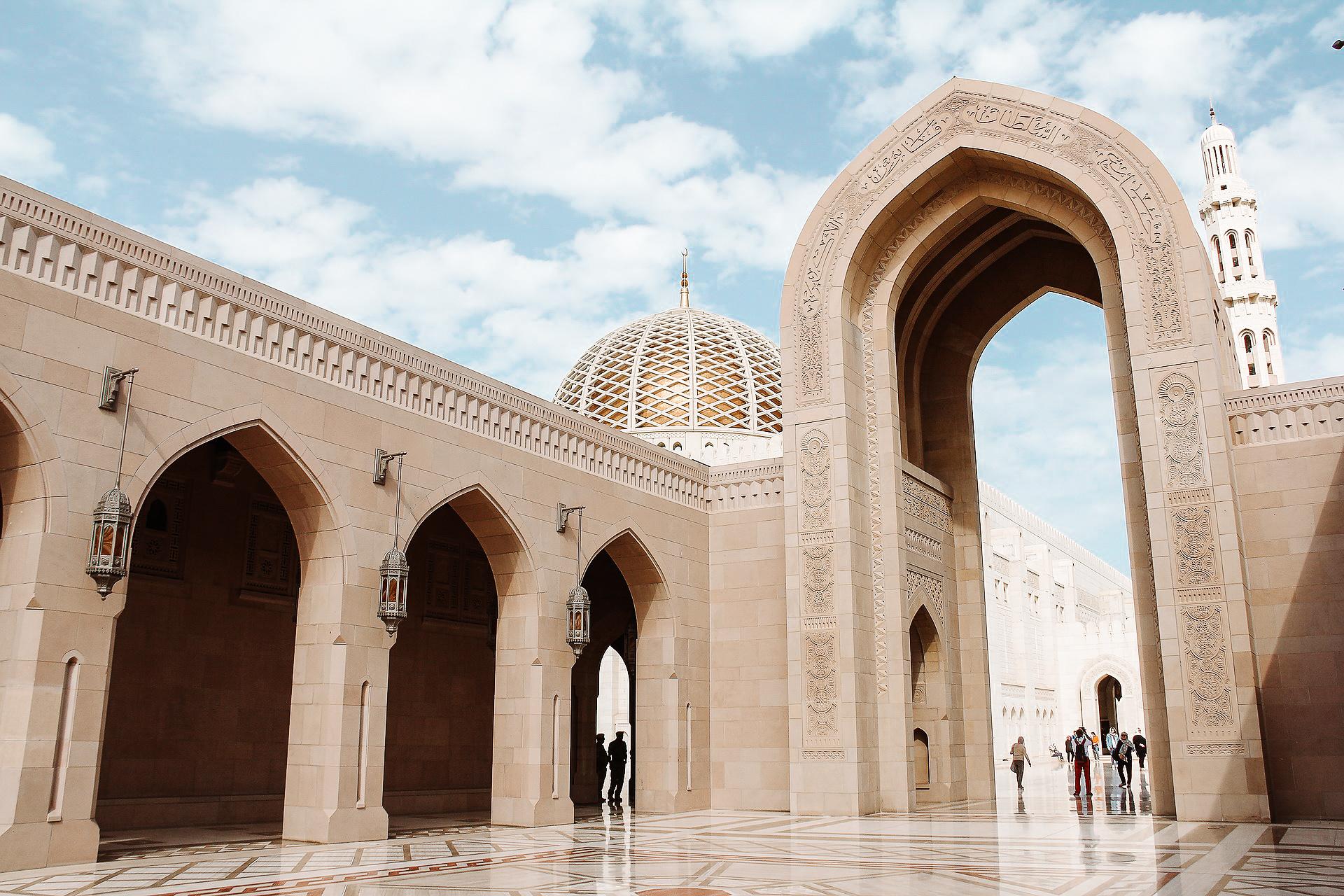
Where to Stay in Oman
Oman is a destination where you can (and should) really splash out on some unique hotel experiences.
When in Muscat, I’d definitely recommend The W Hotel or The Kempinski. These provide the utmost care in luxury and comfort, and are both located right on the waterfront.
For those who really want to splash out in style, look no further than the Shangri-La Al Husn. This hotel captures the essence of Omani architecture and culture in an elegantly designed hotel.
The Pool Villa Tanuf makes a great stay while in Nizwa, especially for families or group travelers.
For a truly unique experience, you can opt to stay in a traditional Omani mudhouse. These are located in some select villages, where you can immerse yourself in authentic Omani culture.
The best mudhouse hotel I found was Hissen Al-Missfah in the village of Hamra.
See More: Things you MUST Know Before Visiting Oman
Getting Around Oman
Most travelers will get to Oman by flying into Muscat. From there, you’ll either rent a car, or join a guided tour to get around the country.
I personally rented a car, and am not sure I can fully recommend it. While having a car allows for the most freedom, there are some serious complications with renting a car in Oman.
First of all, you’ll need to research about the absurdly low daily mileage allowance on rental vehicles in Oman. It’s very hard to not drive over this limit, and when you do, you will be overcharged quite a bit when returning your car.
I would advise joining a tour if you’d like to avoid this hassle altogether.
If you are coming from nearby countries, you have more option on how to get into Oman and could potentially use your own vehicle. It’s possible to drive or even take a bus from Dubai to Muscat if you’re up for it.
Muscat – 2 Days
Your journey always begins in Muscat, the capital city of Oman.
Unlike other middle eastern capitals where the action is usually centralized in one area, Muscat is quite spread out. It can be pretty inconvenient to get around even with a car, so you may want to hire a guide or join a tour.
Muscat is a capital city unlike any other. It is gifted with the geographical beauty of being surrounded by both sea, desert and dramatic mountain peaks – all of which are visible from the city itself.
Here you’ll find glitzy luxury hotels and upscale shopping malls amongst historic fortresses, old souks and grand mosques.
Mutrah
This is the area you’ll want to spend most of your time while in Muscat.
Mutrah is a picturesque port area and neigborhood. It used to be the commercial epicenter of Oman during the pre-oil era, when it served as the main port and point of entry for trade activities.
Today you’ll find tons of restaurants, old souks for shopping, and beautiful views of the sea.
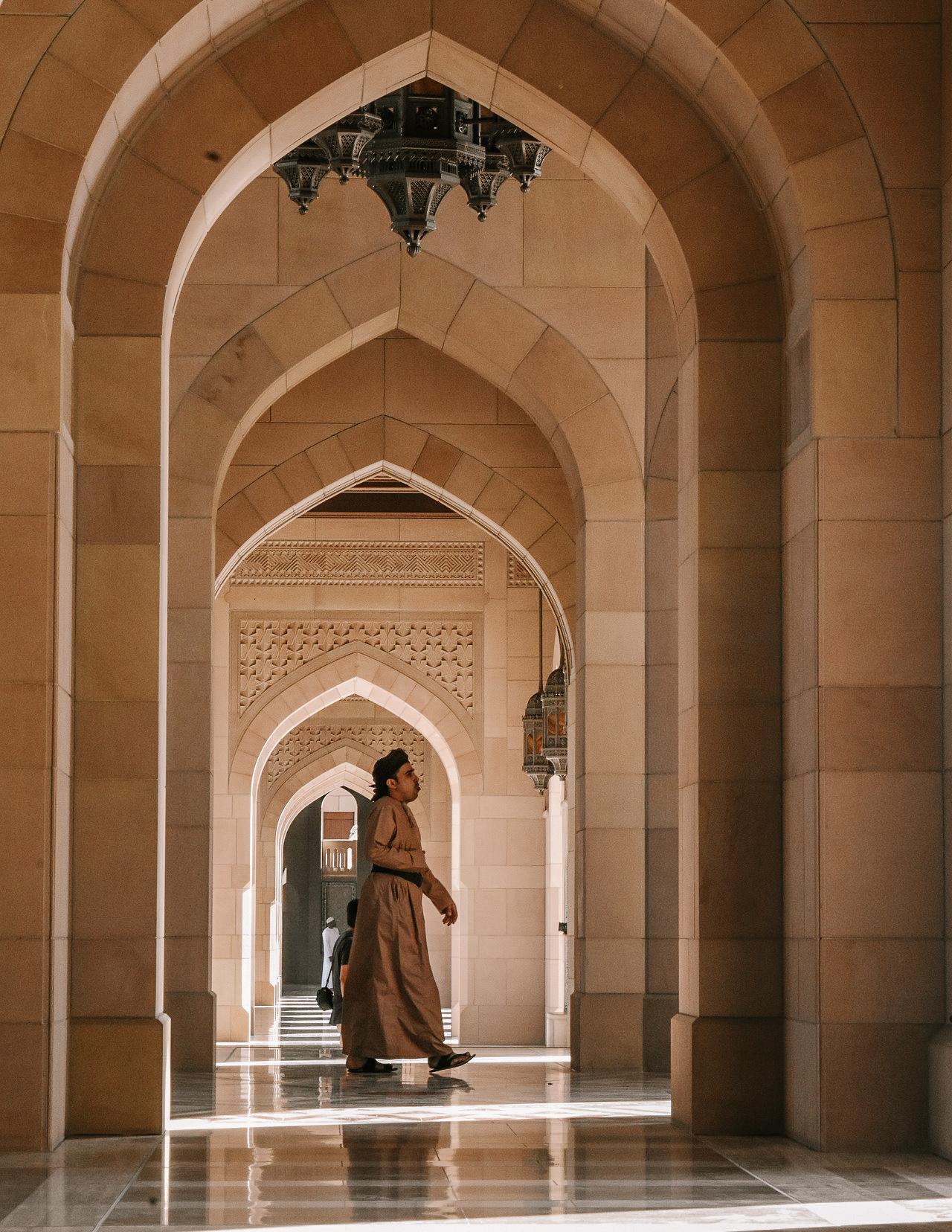
Old Muscat
Old Muscat is a great place to explore on foot and get a feel for a Muscat of the past.
While here be sure to visit the Al Alam Palace, which is still in use today by the Sultan of Oman for certain events.
There are also a couple museums in this area worth exploring. The best museum is probably the National Museum of Oman while here to get some valuable insight into Omani history and culture.
Bait Al Zubair is a smaller museum nearby that is also worth the visit. It houses quite a large number of cultural artifacts regarding Omani culture and life in the past.
Be sure to also head to Al Jalali Fort right along the sea, an area that is quite scenic and great for wandering around during sunset.
This fort was built by the Portuguese in the 1500s, and once served as a jail for Omani royalty. You can visit the interiors of the fort if you’d like to learn more about its history
Sultan Qaboos Mosque

The Sultan Qaboos Mosque was definitely the highlight of our time in Muscat.
It was incredibly beautiful and so impressive, we had to visit twice! Once during the day, and once in the evening.
The mosque has several buildings within its complex, all with beautifully tiled interiors and gorgeous geometrics arches throughout.
It’s hard to say what the most beautiful part of the mosque was: perhaps the golden dome glittering in the sun, or maybe the many detailed, floral tiles within.
It’s only open to the public during certain hours so you will need to do a bit of planning to time your visit. I’d say you will want to have at least a full hour to enjoy the mosque, and more if you want to take pictures.
I found the mosque to be crowded during the day, even when we visited early in the morning. Visit as early as possible for potentially thinner crowds.
The Opera House
A beautifully grand building to view from the outside. The design is truly unique, blending tradition with modernity. The building is impressive at any time, but I particularly found it to be beautiful at night.
Wadi Shab & Sur – 1 Day
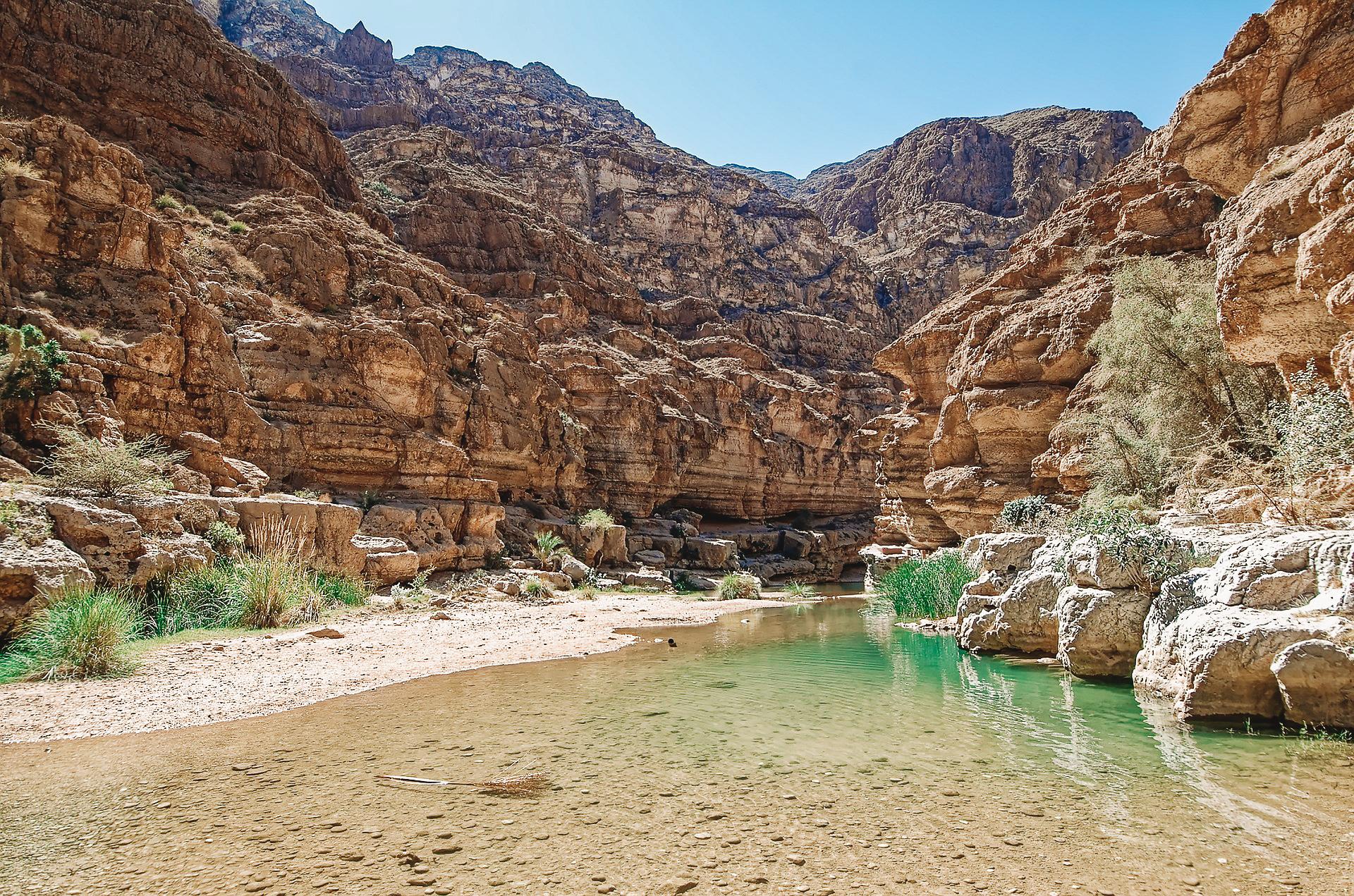
Venture out of the city and head towards the wadis of Oman.
Wadi literally translates to valley in Arabic. Usually a wadi in Oman is where a water source cuts through rock or valley to form a lush oasis, ideal for swimming.
These Wadis are all unique. Some are more like deep pools of water, while others are winding river valleys that require a hike.
Wadi Shab
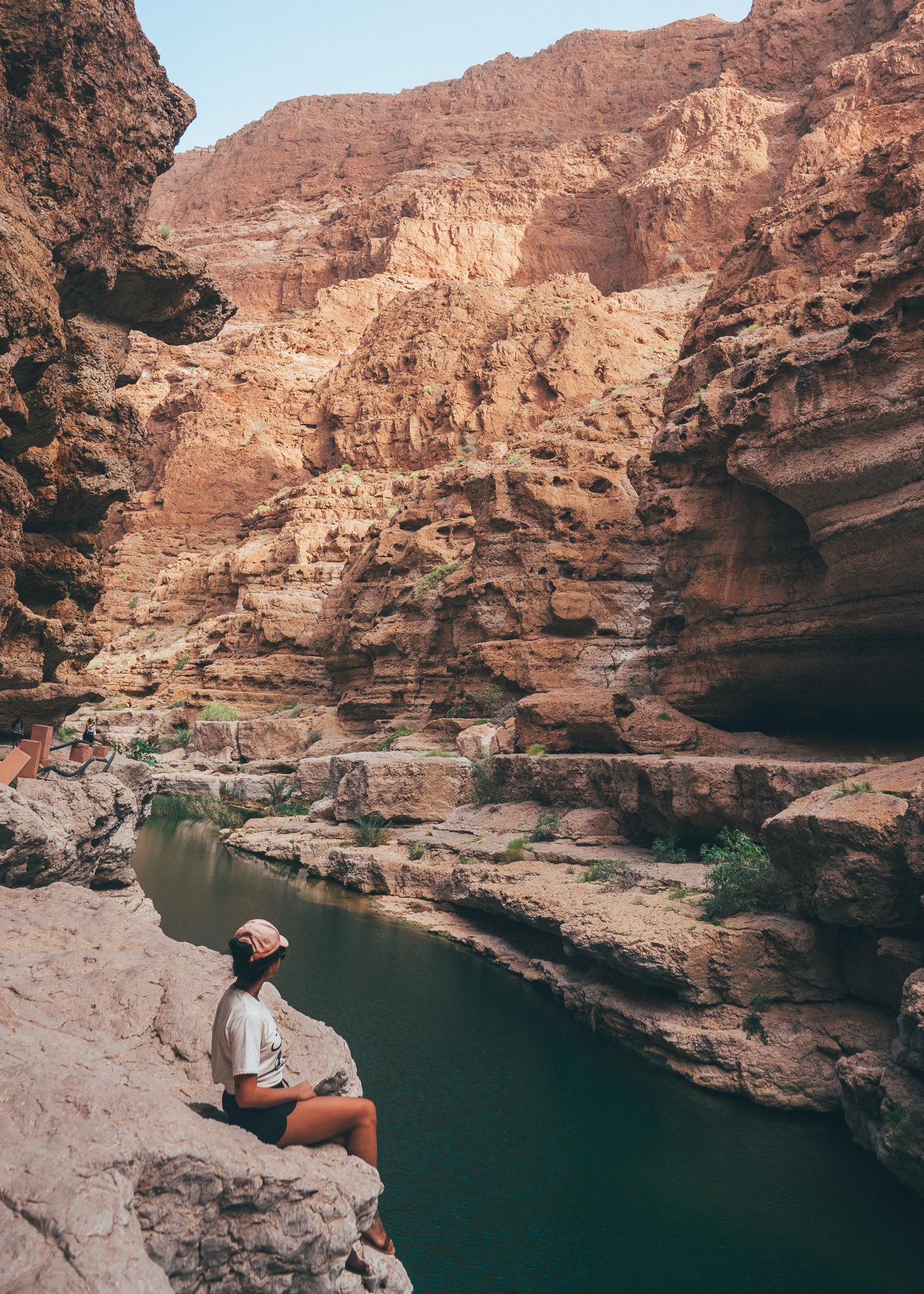
If you only have time to visit one wadi in Oman, I’d recommend Wadi Shab.
It’s located in a fairly convenient location, not too far from Muscat and on the way to further attractions in Oman.
It requires some hiking to reach the end point, but this is done mostly on a flat, somewhat maintained path.
It is 45 minutes of hiking in and out, and can be slippery in some spots so bring proper shoes. You’ll also want to bring your own water and snacks as there won’t be anything on the way but nature.
What makes this wadi worth it it the gorgeous pools of water at the end of the trail.
From these pools you can even swim into a cavern with its own waterfall.
Note: Not all wadis in Oman are ok with female bikinis. So be sure to check the rules of each one you visit. This one is bikini friendly. Wadi Shab is bikini friendly.
Want More Middle East Destinations? Read: The Perfect Egypt Itinerary
Sur
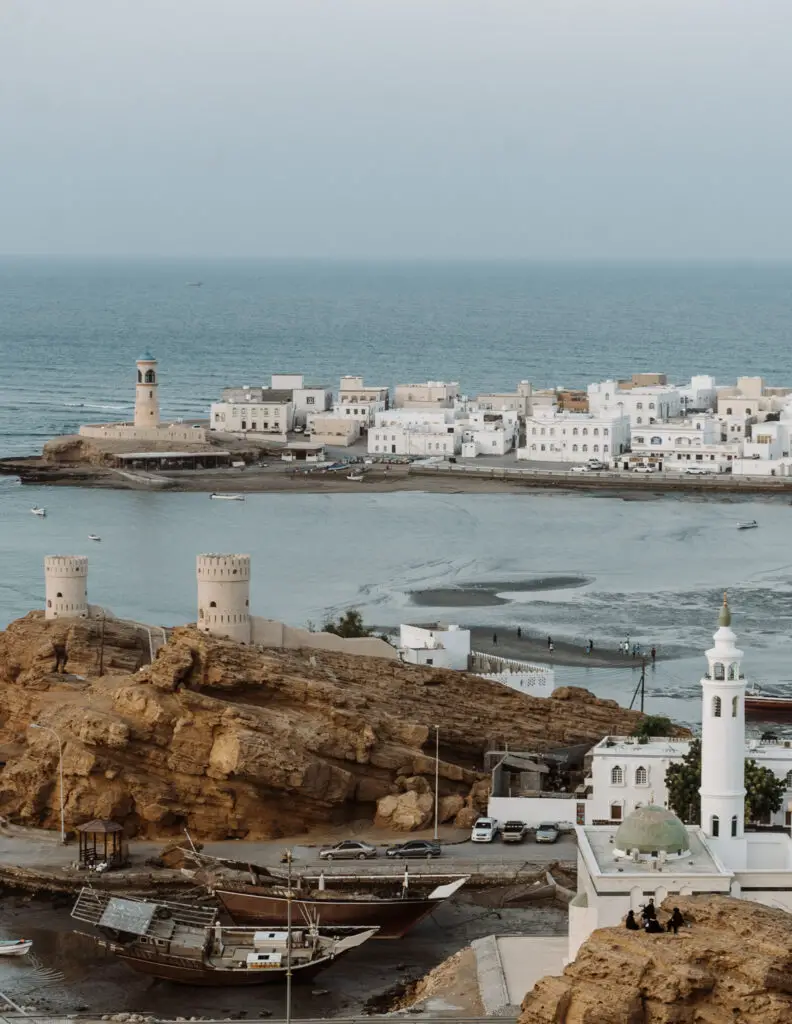
Not too far from Wadi Shab is the small coastal town of Sur. After you swim and hike for the day at the wadis all day, its nice to come here to wind down, get some ocean air and enjoy a fantastic sunset.
The coastal town of Sur has a history as a port city. The historic shipyard remains intact and you can still see today from the beach.
The beach area in Sur is a great place to explore. There are fortresses nearby, and the old quarter near the Al Ayjah Lighthouse feels like stepping back in time.
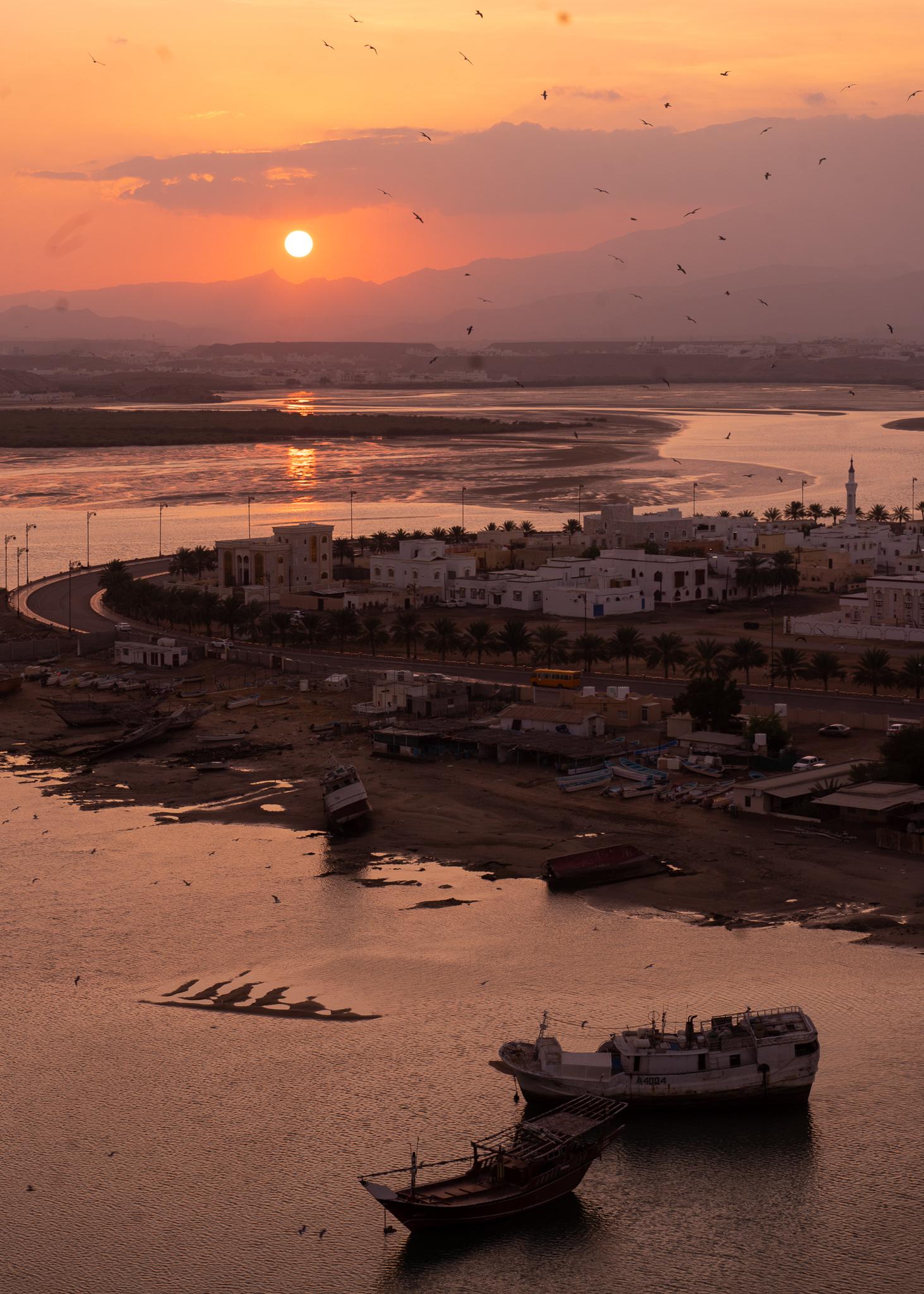
But the real show begins once you make the small hike up the watchtower hill to watch the sunset.
From this viewpoint, you’ll have unobstructed views of the sea and watch the sun set as thousands of birds take to the skies. It’s simply magical.
Wadi Bani Khalid – 1 Day
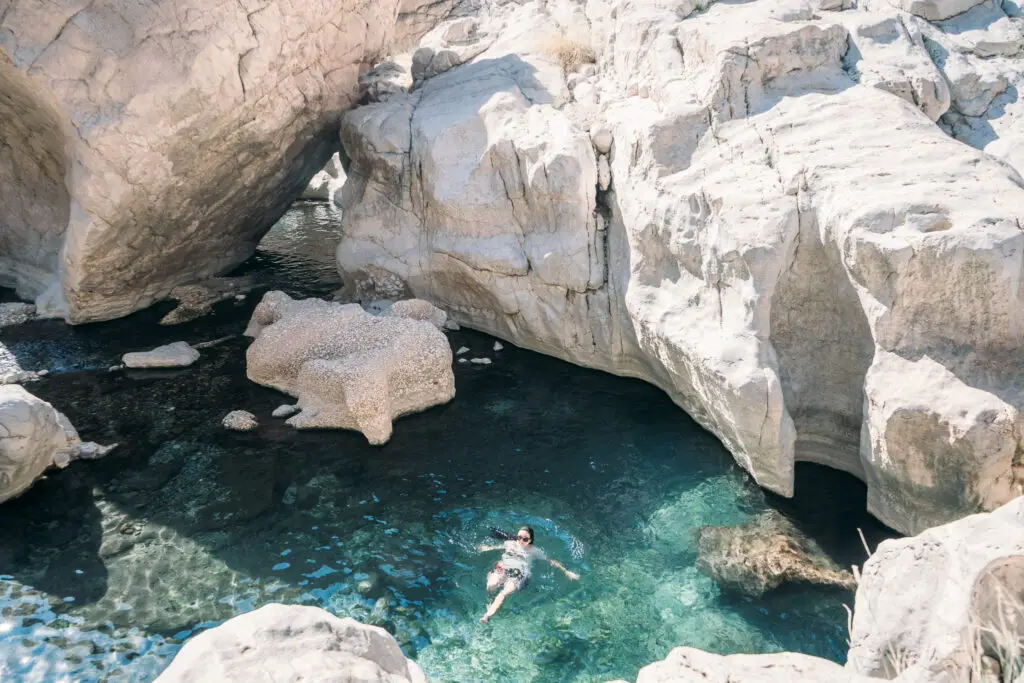
Another wadi well worth the visit in Wadi Bani Khalid.
This one is quite different than other wadis. Unlike Wadi Shab which is mostly rugged and left natural, Wadi Bani Khalid has some infrastructure built around it making it more visitor friendly.
There is a paved walking path, locker rooms, bathrooms and even a swimming pool onsite.
This wadi is definitely geared more towards locals than foreigners so that means, local rules apply here.
Women will be required to wear clothes while swimming, in accordance to local customs. It’s not really a big deal, ad you get used to it pretty quickly.
Getting to the pools in Wadi Bani Khalid requires no hiking. You’ll be able to swim and explore the many small canyons and caves throughout the park.
The water here is the most strikingly clear blue. Unlike Wadi Shab with its characteristic red rocks, Wadi Bani Khalid is comprised of a slick white, marble-like rock.
It’s beautiful, but slipper so tread carefully.
Wahiba Sands, Omani Desert – 2 Days
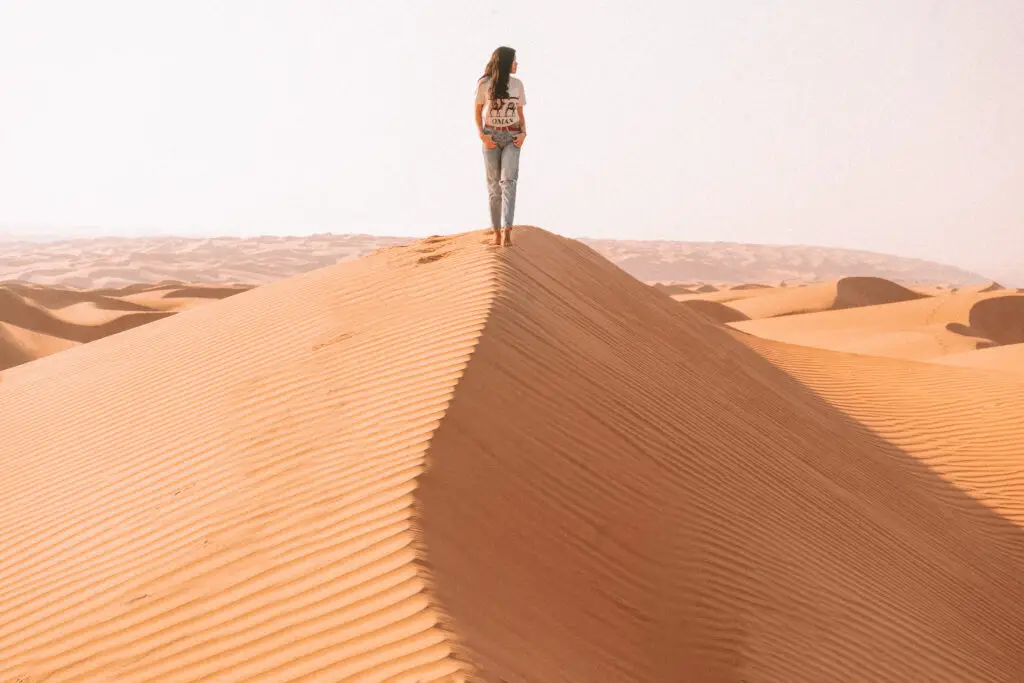
The entire country of Oman is technically characterized by desert landscapes. But if you want to immerse yourself in the classic desertscapes of sand dunes and vast nothingness, Wahiba Sands is the best place for that.
This is where you’ll find the largest sand dunes in the country. To get here, you’ll have to drive to the nearby town of Bidiyah
From there, you’ll definitely need a 4 x 4 to make it into the desert. If you didn’t rent a 4 wheel drive car, you can always join a guided tour which is likely better anyway, as a local guide will be able to navigate the desert seamlessly.
This desert may seem barren and uninhabited, but it is actually home to the Bedouin people. These are an indigenous, nomadic group found in deserts as far as Jordan and Kuwait.
If you’d like, you can join a tour to experience their way of living by staying in an overnight desert camp.
If you are a lover of desert landscapes like me, you’ll definitely want to stay one or two days for those dreamy desert sunrises and desert nights.
Aside from taking in the beautiful views, other activities to enjoy in Wahiba Sands are visiting and/or riding camels, go on a walking tour of the dunes, or go dune bashing by car.
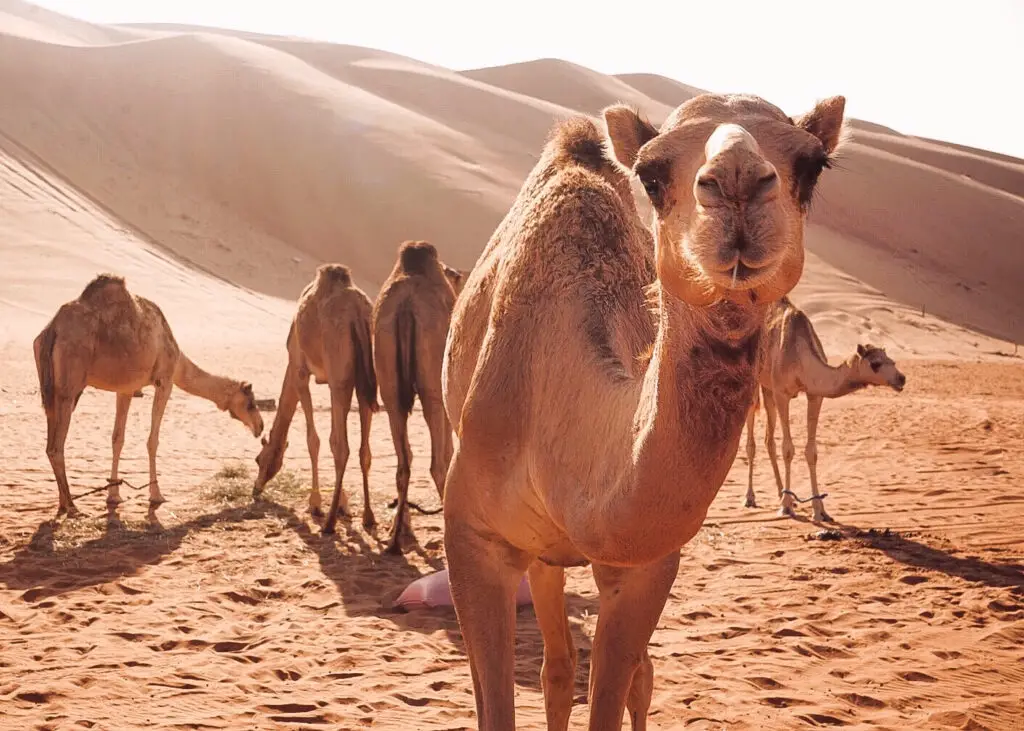
Salalah (Only in June to August in Rain Season) – 3 Days
To get to Salalah, you have two options:
- Drive here after Wahiba Sands, and later drive up back to Muscat to finish the road trip (roundtrip its 19 hours of extra driving)
- Skip this step now, and head to Nizwa and the locations listed later in this post. You’ll eventually loop back to Muscat, and from there you can fly to Salalah instead.
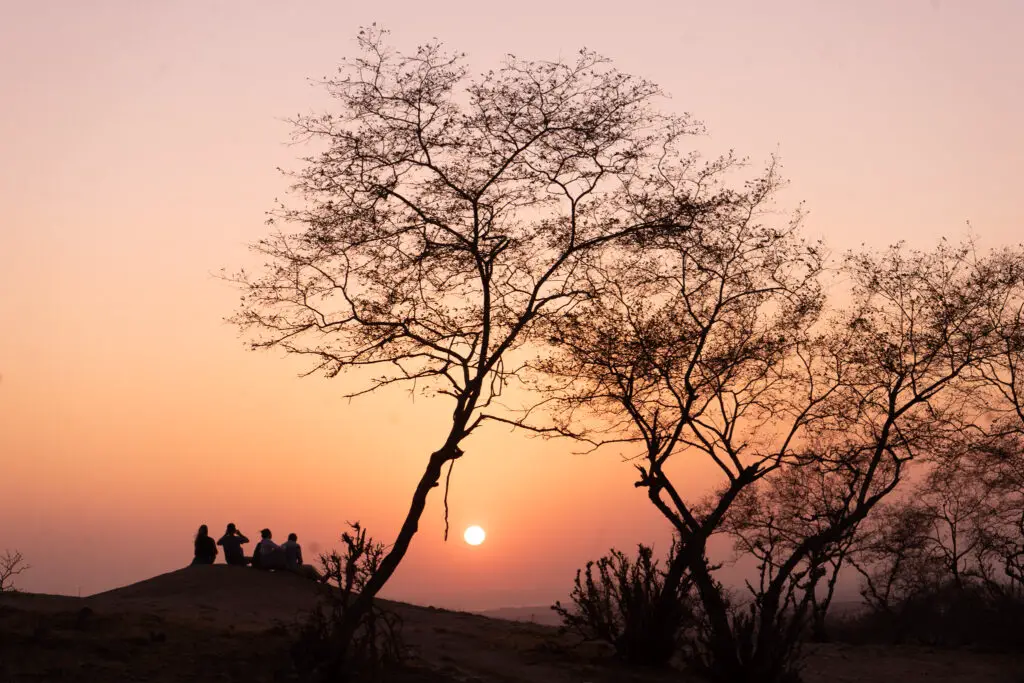
Salalah is a locally beloved area in Oman. In the summer months, the entire country of Oman is scorching hot, making it unbearable even for locals.
Many will opt to head to Salalah, a rainy oasis with cooler temperatures in summer known for its gorgeous waterfalls and wadis for swimming.
The waterfalls are at their peak during summer during the rain season. Honestly, if you are visiting outside this season, there likely won’t be much water in the waterfalls so you may want to skip to the alternative destination later in this article.
We did visit in winter, and the waterfalls were basically non-existent. We still had a great time exploring the beaches, towns and wadis, but I understand the long drive may not be worth it for everyone.
Things to consider: It’s a full day of driving from Wahiba Sands, and there isn’t much to see on the way. Most people would rather go back to Muscat and fly, so that’s something to keep in mind. We decided to drive, and were treated with lots of wild camel sightings on the way.
Ayn Athum Waterfall
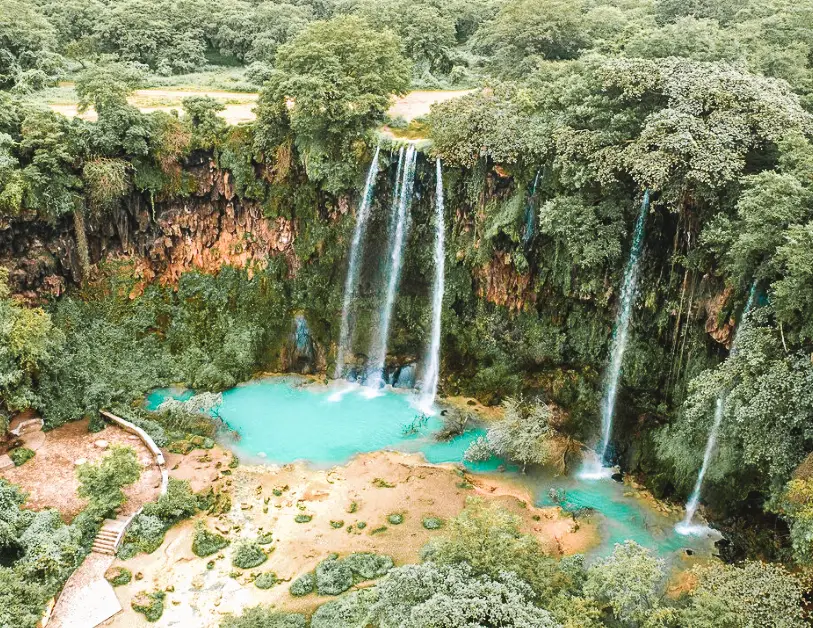
This elusive waterfall only forms in summer months when the big rains create several free-falling waterfalls. This water falls into a bright turquoise basin surrounded by the lushest greenery.
Unfortunately, you won’t see any water here in winter, and the trees will also be brown and wilted. If you want to see this, its definitely worth timing your 14 days in Oman road trip to be in summer!
Ayn Khor Waterfall
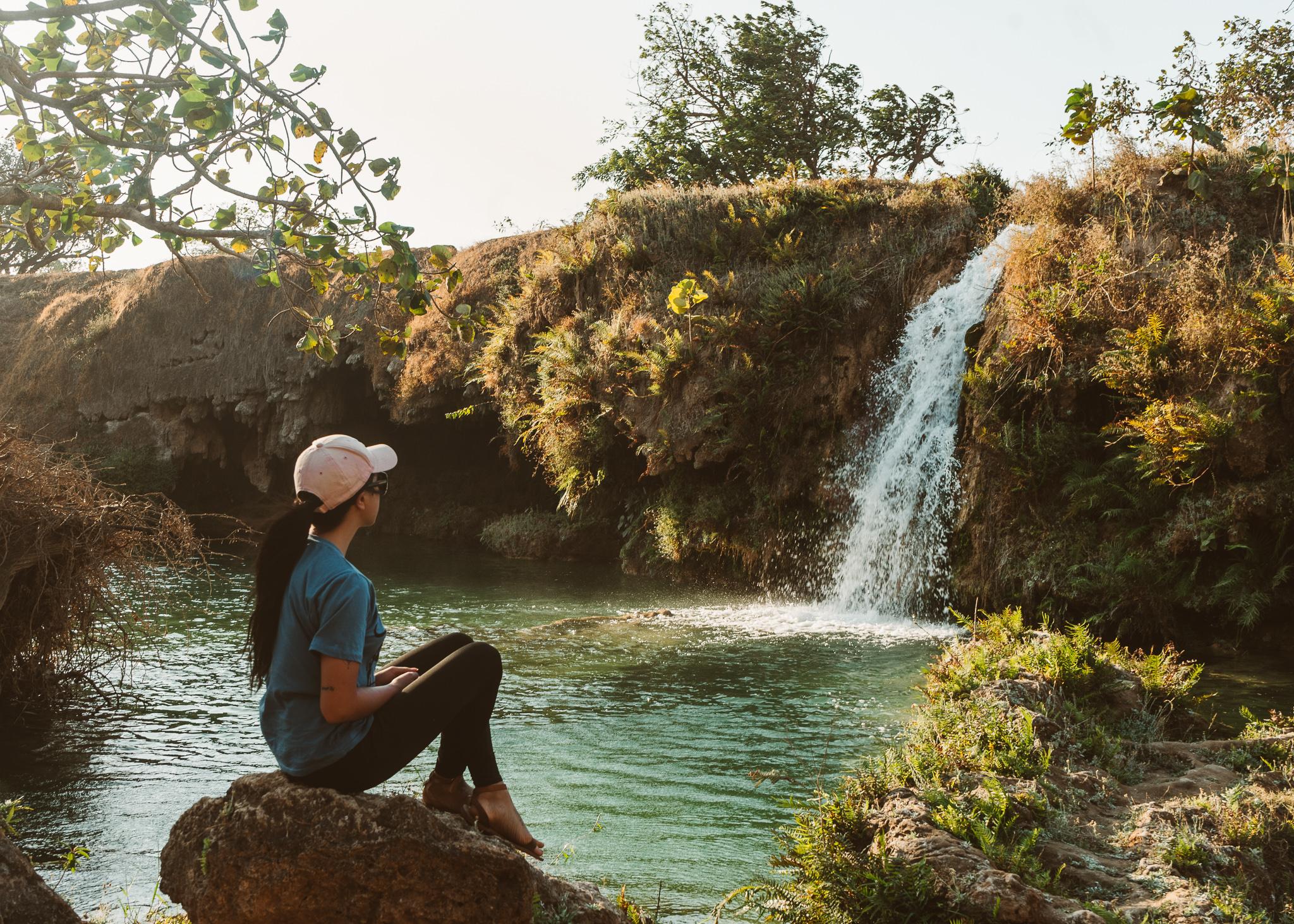
Another spectacular waterfall that only makes an appearance in rain season. It’s not as big as or tall as Ayn Athum Waterfall, but it’s a popular swimming spot for locals.
Come in summer to take a refreshing dip in the bright blue waters, and be amongst the locals enjoying the same.
Wadi Darbat
This wadi is green and full of life year round, so if you’re visiting in winter this is going to be the highlight.
In this wadi, you’ll find camels and even cows wading in the waters.
Unlike other wadis, this one is more of a flood land than a river or pool. You can explore the area on food as many locals do.
You’ll find beautiful emerald pools of water and waterfalls all around. During summer and the rainy season, the water gets high enough that you can even go for a boat ride across the wadi.
Al Mughsayl Coast
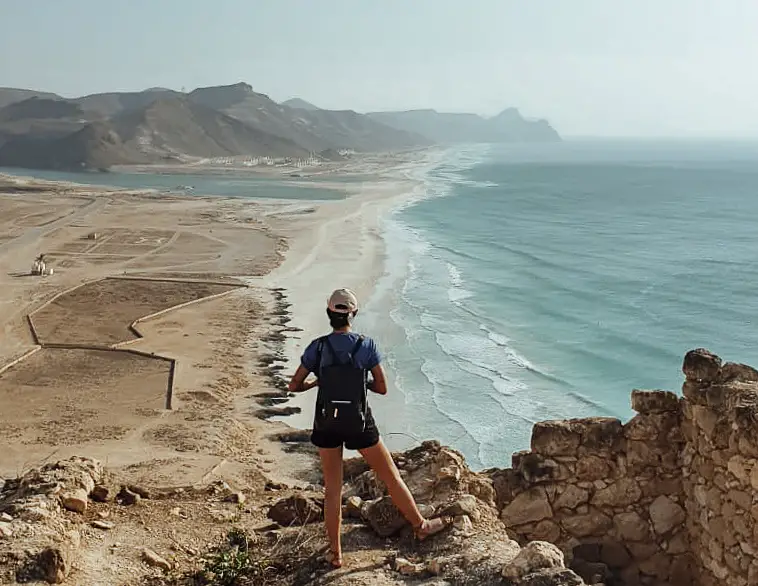
Al Mughsayl is a long stretch of coastal cliffs and beaches. It’s known for having some gorgeous views, which you can enjoy from the beaches, or by hiking up some of the many hills and cliffs.
This area is great for hiking and just enjoying nature. The beach here was one of the best we encountered in Oman, with very little waves and rocks.
It’s very warm and you can definitely go for a swim if you’d like.
Gravity Spot
Similar to the mystery spot in Santa Cruz, there is a quirky place in Selalah where gravity seems to not exist.
Interestingly this spot is located right along a stretch of highway and if you blink you may miss the signs for it,
When you do find it, park your car, and grab something round. Roll it down the hill, and wtch it slowly roll back to your, up the hill.
You can also put your car in neutral, and see how it slowly rolls back up the hill on its own.
These are simple pleasures, but you’d be surprised how long we (an a queue of other cars) were playing around here with the anti-gravity. We were like 5 year olds who just discovered puppies.
You can find this No-gravity spot here.
Nizwa and Surrounding Areas – 2 Days
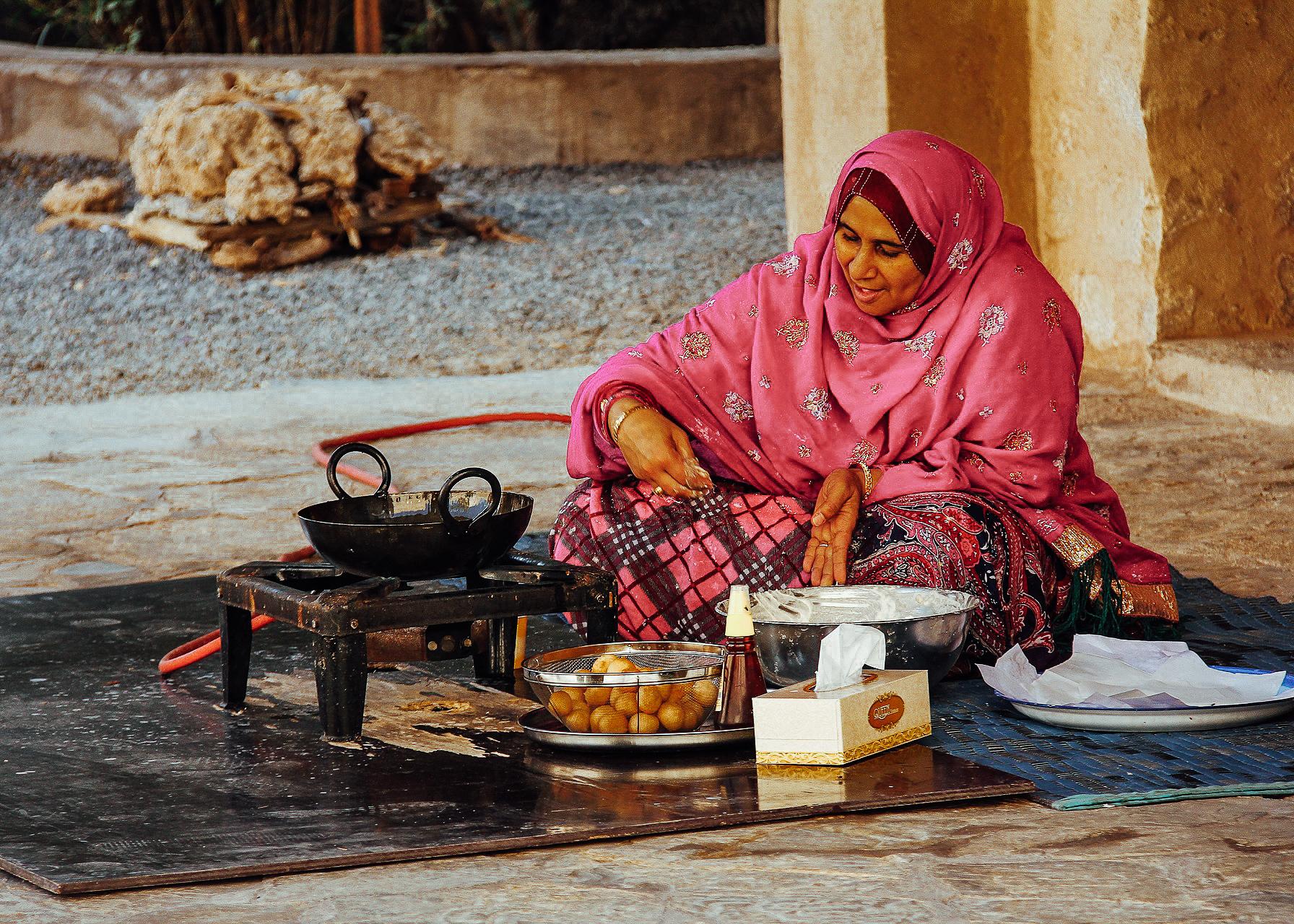
After Salalah (or Wahiba Sands, depending which route you chose), your next stop on your 2 week itinerary in Oman is Nizwa.
As you’ll quickly notice on your Oman road trip, Oman has no shortage of historic fortresses located throughout the country.
But Nizwa is without a doubt the most impressive one. While in this area, you can visit 2 of the largest and most famous fortresses in Oman, and the surrounding villages.
Nizwa Fortress
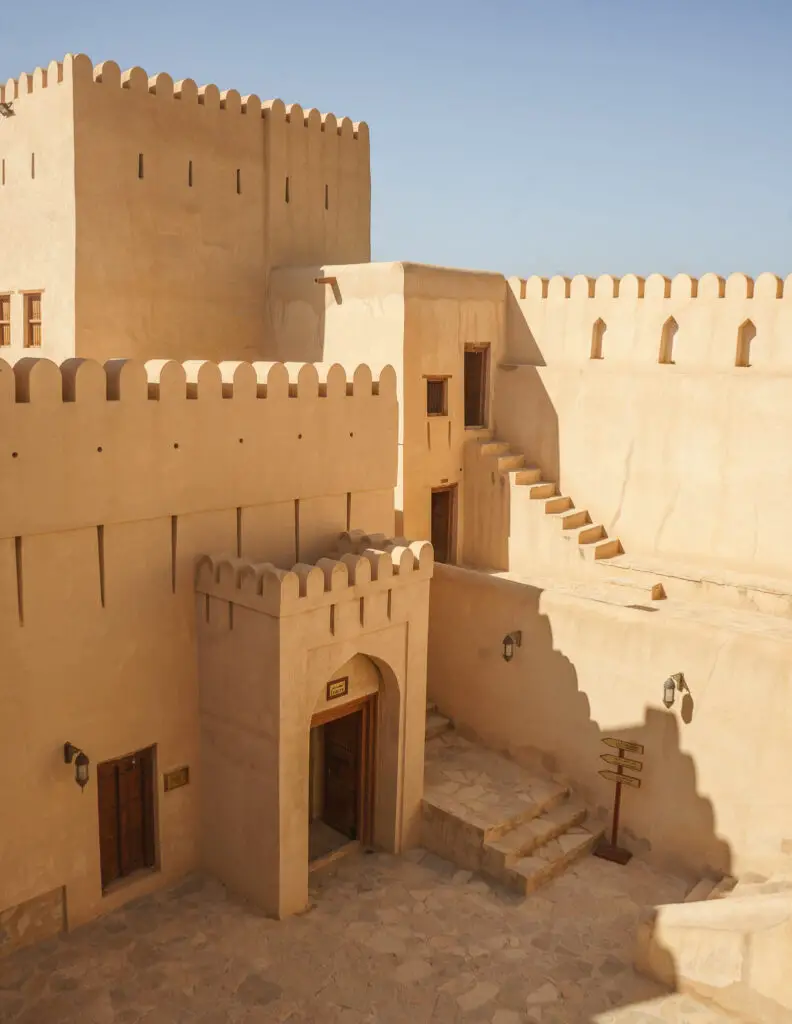
Nizwa fortress is most recognizable by its unqiue appearance. A fortress comprised of only a sandstone color and geometric block shapes, this fortress is a photographers playground.
On top of that, Nizwa fortress also holds strong historic significance. While here you can learn the fascinating history if how this fortress was used as a stronghold in defending the kingdom from invaders.
I found a great deal of amusement from learning about the murder holes, secret chutes within the castle walls in which they used to pour hot, melted dates (yes, the fruit) down into in order to burn and kill intruders.
Bahla Fortress
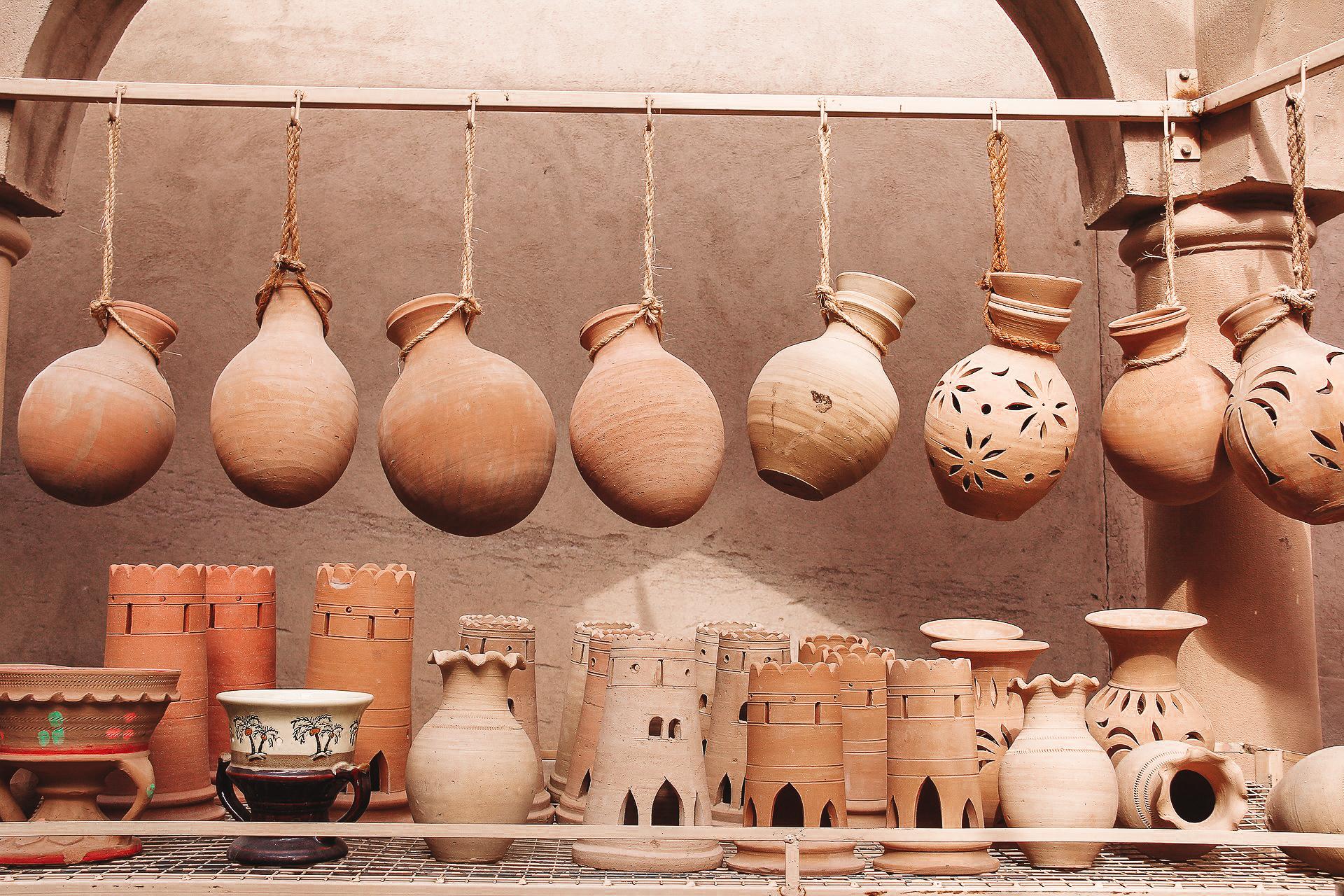
Bahla Fortress is not far from Nizwa at all, and it is somewhat similar. It’s not as impressive and on the same scale as Nizwa fort, but it is a UNESCO site and worth the visit.
Like Nizwa Fort, it is comprised of mud bricks. The fort and surrounding villages were once ruled by the Nabahina tribe. They made this a prosperous and wealthy area during the height of their rule.
Al Hamra
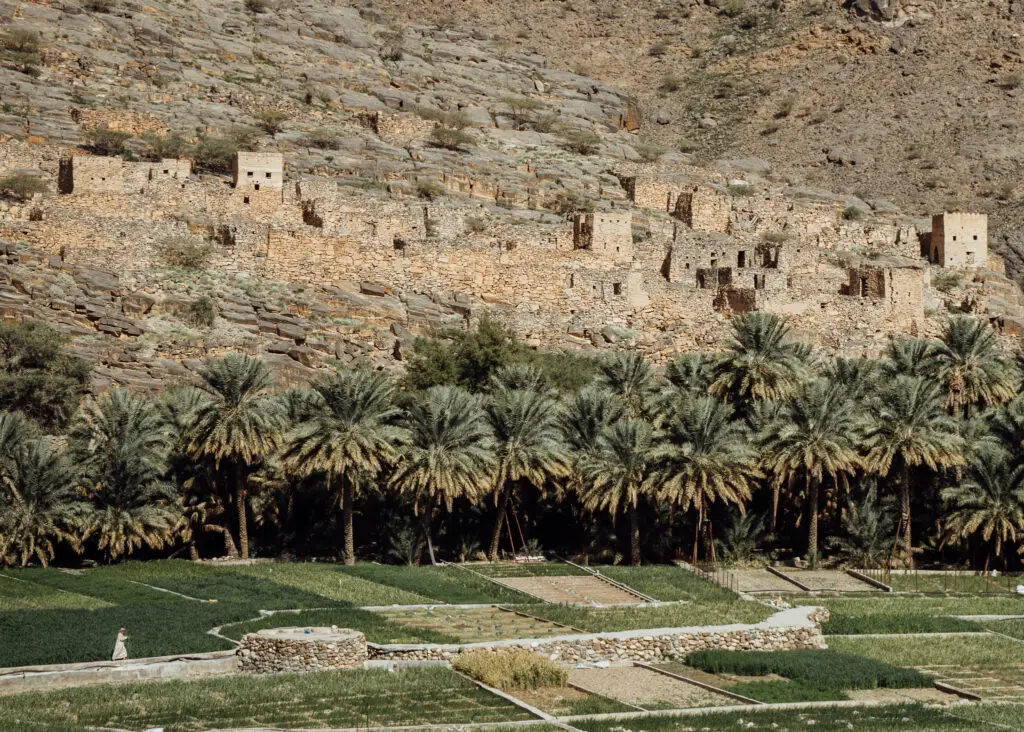
Al Hamra is an ancient village, located at the foot of the Hajar Mountain range. This village looks pretty much the same as how it may have looked a long time ago, despite being abandoned long ago.
Like visiting a ghost town, Al Hamra is a great place to wander and to gain some insight into what life was like here in the past. Something unique about this place it that it has a very sophisticated irrigation system, which you can still see today.
Known as aflaj, this ancient waterway was a civil engineering feat of its time. It comprises of several autonomous watering channels, that allowed scarce water to reach agricultural areas, in an otherwise inhospitable environment.
Little is known about the first settlers of Al Hamra. However, these channels are estimated to be as old as 4,000 years old, making this one of the oldest villages still in tact in Oman.
Overnight Stay in a Traditional Mud House
In nearby Mistfah you can find the Hussen Al-Mistfah Mudhouse.
This is a restored and renovated mud house turned into a hotel. Here, you can experience what it’s like inside an authentic Omani house, but with all the modern comforts such as wifi and meals provided on their rooftop.
Book the Hussen Al-Mistfah Mudhouse here.
Jebel Shams & Wadi Ghul – 2 Days
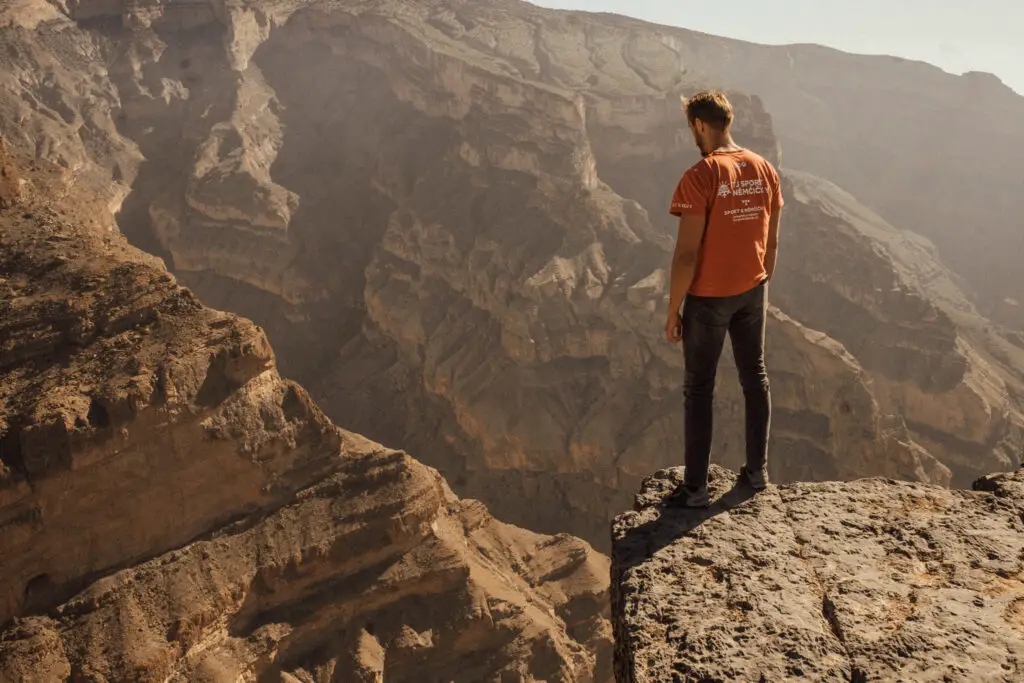
Wadi Ghul
Wadi Ghul is nicknamed the “Grand Canyon of The Middle East”, and once you see it you’ll see that it definitely lives up to the name.
As the largest and deepest canyon in the entire Middle East, and the second largest in the world, this canyon is a spectacular place to marvel at nature.
To get here, you will definitely need a 4 wheel drive car. Again, if you didn’t rent the proper car, just opt to join a tour for convenience and safety.
A tour is also the easiest way to navigate the canyon. As massive as the canyon is, the entire area does cover a lot of ground and the points of interest are quite scattered and confusing to find.
Whether you come y car or tour, you’ll definitely spend some time driving through this area and stopping to explore along the way.
The drive will take you alongside areas of steep, humbling cliffs, intricately carved canyons and incredible rock formations.
If it isn’t too hot, many visitors opt to hike. A popular hiking trail is called the “Balcony Trail”, which takes you along the rim of one of the most scenic spots in the canyon.
Jebel Shams
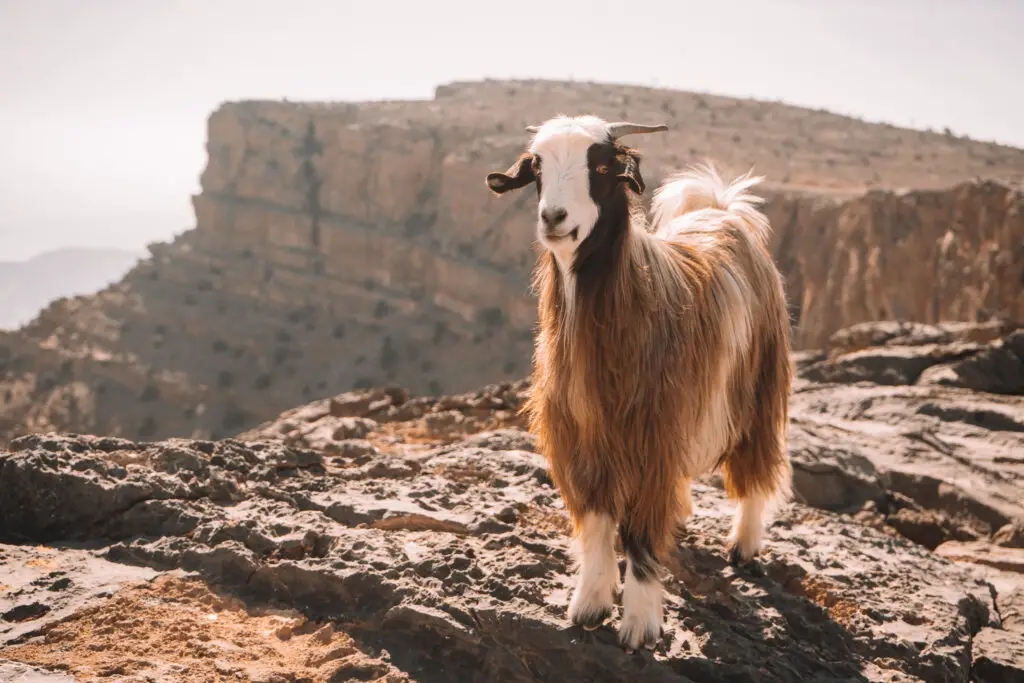
Jebel Shams is a mountain peak inside the Wadi Ghul canyon, and the highest peak in all of Oman.
To get here requires yet some more sophisticated driving in a 4 wheel drive car on some questionably rough roads. However, the reward is worth it.
The views from Jebel Shams is simply out of this world. You’ll feel like you are quite literally at the ends of the earth and on top of it at the same time.
Many visitors will choose to stay overnight in one of the lodges on Jebel Shams. If you have enough time for it, I’d definitely recommend this as those sunsets and sunrises are to die for.
After Jebel Shams, head back to Muscat to either end your trip or head on to one last location.
The Arabian Peninsula (Visit Any Season) – 3 Days
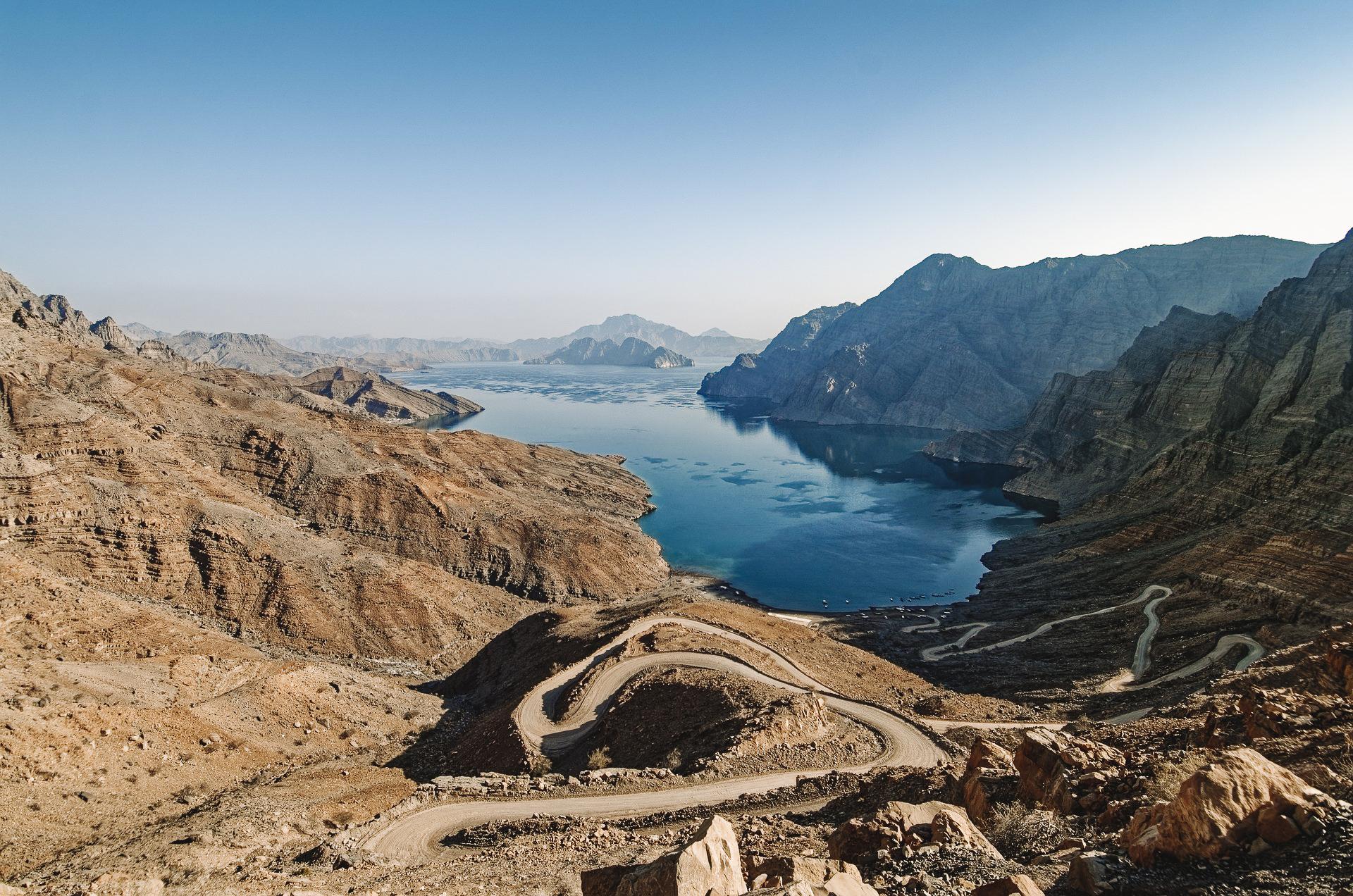
If you visit outside of the rain season, and can’t see Salalah’s waterfalls in their glory, or you have more than 2 weeks in Oman, head north to see the Musandam Fjords.
Also known as the Arabian Peninsula, this area boasts sweeping views of the sea and mountains, and some of the best diving in this region. Here, you can dive, kayak or take boat rides to experience this special place.
You should probably fly from Muscat, since the drive would take you across the border, into the UAE, before crossing back into Omani territory which can be a hassle.
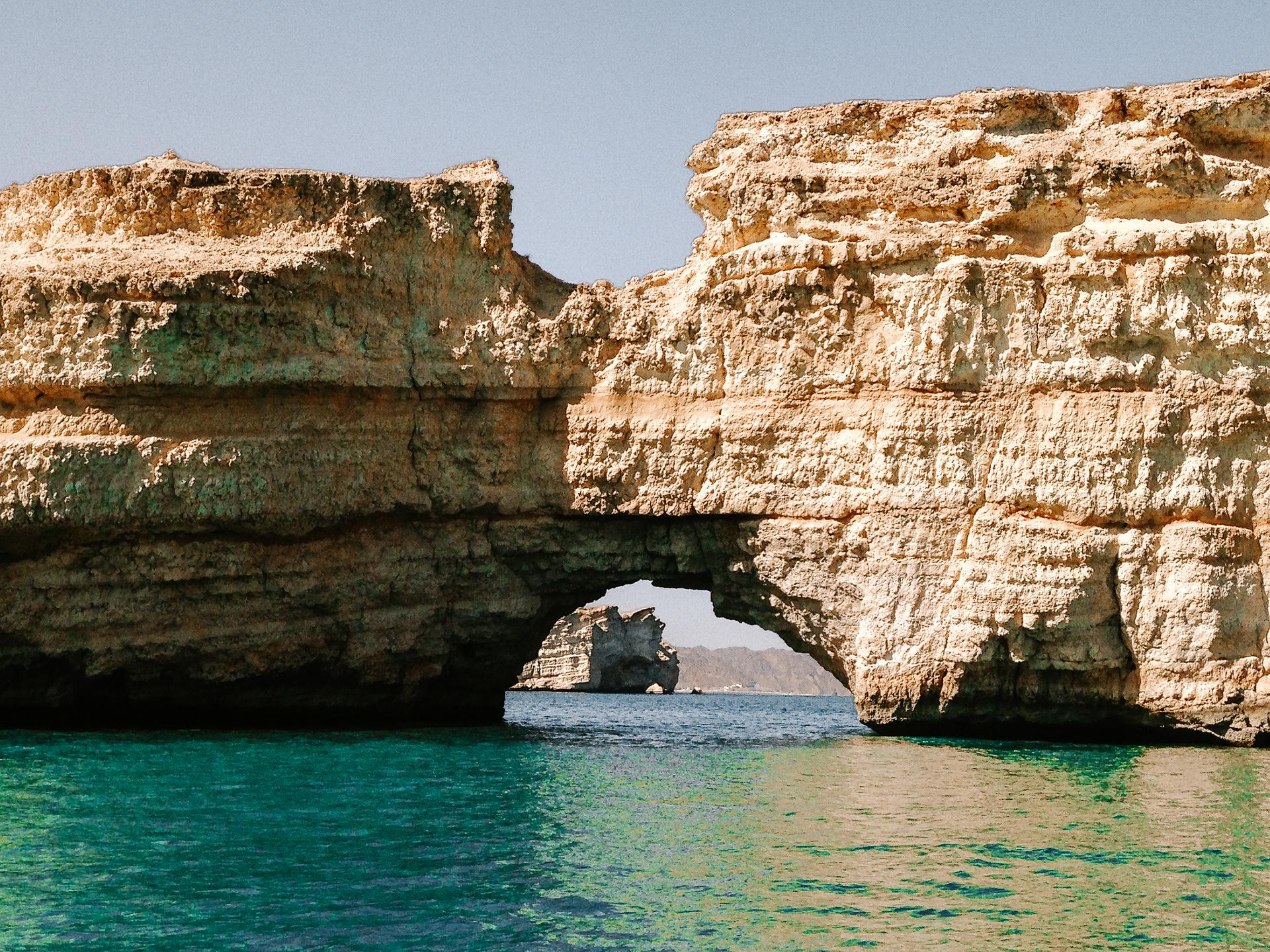
Oman Road Trip FAQ
Are the roads in Oman safe for driving?
Most roads in Oman are in perfect condition, especially the ones in and around Muscat, Nizwa and all major cities. But once you venture off into the mountains or to more rural villages, a 4 wheel drive becomes necessary.
What is the Best Month to Visit Oman?
If you’re after the most comfortable temperatures in most of the country, December is the best month. If you want to visit the waterfalls in Selalah, then visiting in July or August is best.
Is Oman an expensive country?
Yes, 1 Omani Riad is usually valued at around 2.5 – 2.7 USD, as the third highest value currency in the world. As a result, things cost more. If you are a mid-range traveler, You can expect to spend $150 – $200 a day, if splitting the car rental with another person.
And that wraps up your 2 week itinerary in Oman.
Have you been to Oman? What did I miss?
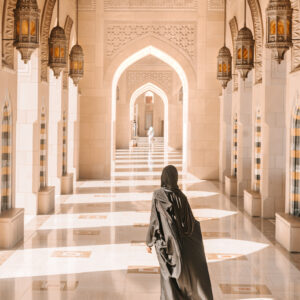 9 Things you Must Know Before Traveling to Oman
9 Things you Must Know Before Traveling to Oman

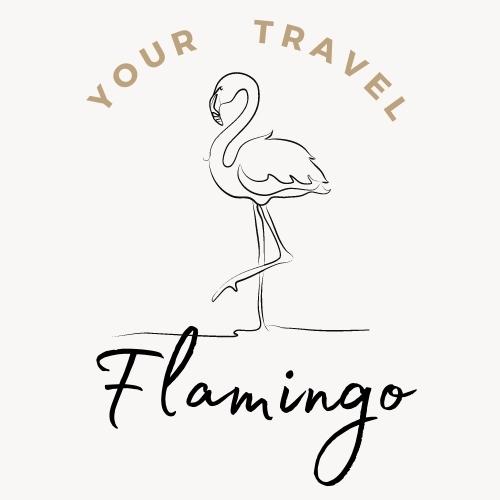
What a beautiful country – I had no idea there was so many gorgeous landscapes in Oman! Definitely want to visit now!
This is beautiful, it had evertything right from desert to abandoned fortess to waterfalls. This is my kind of place, though I have heard there are few travel restrictions that needs to be followed while visiting Oman. Any restriction in particular which you would like to share?
Really looks like ither-wordly out there in the desert and the unique architecture, too!
My friend used to go for official visits to Oman and I was fascinated by the stories he had to tell. And now I have no doubts when I read your blog and these wonderful pictures that you showed of this country. Thanks for sharing!!
Your pictures of Oman are breathtaking! Its not somewhere people typically visit. What made you want to visit? Thanks for teaching me about Oman
What an awesome trip! Oman looks epic. It is very high on my list of next trips. Your pictures are great. I love the goat XD. Following you on socials!
It is a great, very inspirational post and informative itinerary. I would love to visit Oman with your detailed itinerary and tips.
Your pictures are wonderful! I spent 10 days in Oman and loved it, I think Wadi Bani Khalid was my favourite place!
Извините за то, что вмешиваюсь… Я разбираюсь в этом вопросе. Готов помочь.
Probably, I am mistaken.
I advise to you to look for a site, with articles on a theme interesting you.
http://www.petsinform.com/forum/viewtopic.php?f=31&t=34024
https://www.digitalcorvettes.com/members/winnitalycom.195006/
https://wellfound.com/u/phillips-patricio
https://1xbetnplogin.com/
https://winnita-promocode.com/
https://1xbetvnlogin.com/
https://kharkov.forumotion.com/t2167-topic#8054
https://dissertation-now.com/
https://dissertation-now.com/essaygoaway-com/
https://pq.hosting/help/komanda-ln-v-linux
https://naasongs24.com/1xbet-india-reviews-read-customer-reviews.html
The site makes it possible to get in touch with experts for temporary risky tasks.
Users can securely set up support for specialized needs.
All workers are qualified in managing intense tasks.
hitman-assassin-killer.com
This site ensures discreet communication between requesters and freelancers.
For those needing immediate help, our service is the right choice.
Submit a task and connect with an expert today!
Il nostro servizio offre l’assunzione di operatori per compiti delicati.
I clienti possono scegliere candidati qualificati per lavori una tantum.
Gli operatori proposti vengono verificati secondo criteri di sicurezza.
ordina omicidio
Attraverso il portale è possibile visualizzare profili prima della scelta.
La qualità continua a essere un nostro valore fondamentale.
Iniziate la ricerca oggi stesso per trovare il supporto necessario!
This website, you can discover a wide selection of slot machines from top providers.
Players can try out traditional machines as well as modern video slots with vivid animation and interactive gameplay.
If you’re just starting out or a casino enthusiast, there’s a game that fits your style.
play aviator
Each title are ready to play 24/7 and optimized for laptops and tablets alike.
All games run in your browser, so you can jump into the action right away.
Platform layout is easy to use, making it quick to explore new games.
Sign up today, and discover the world of online slots!
https://www.bookmarkcart.com/author/roscargr/
https://bookhalifatickets.com/rent-a-car-in-dubai/
Looking for a person to take on a one-time risky task?
Our platform focuses on connecting customers with freelancers who are ready to tackle critical jobs.
If you’re handling emergency repairs, unsafe cleanups, or complex installations, you’ve come to the perfect place.
Every listed professional is pre-screened and certified to ensure your safety.
hitman for hire
We offer transparent pricing, detailed profiles, and secure payment methods.
Regardless of how challenging the scenario, our network has the skills to get it done.
Start your search today and find the ideal candidate for your needs.
In this place you can easily find distinctive promo codes for 1xBet.
The variety of rewarding options is often modified to ensure that you always have means to utilize the newest arrangements.
With these special offers, you can lower spending on your bets and improve your probability of winning.
All special offers are diligently inspected for validity and functionality before showing up.
https://store.zamilco.com/storage/pages/?ghenskaya_beremennosty_ne_byvaet_strashnoy.html
Moreover, we furnish comprehensive guidelines on how to put into action each promo code to improve your rewards.
Note that some arrangements may have specific terms or expiration dates, so it’s essential to review attentively all the aspects before implementing them.
Hello to our platform, where you can discover premium materials designed specifically for grown-ups.
The entire collection available here is intended only for individuals who are over 18.
Ensure that you meet the age requirement before proceeding.
teen videos
Experience a one-of-a-kind selection of adult-only materials, and immerse yourself today!
This online service features a wide range of prescription drugs for ordering online.
Customers are able to securely access essential medicines without leaving home.
Our catalog includes both common treatments and custom orders.
The full range is acquired via reliable providers.
fildena strong 120 mg
We ensure customer safety, with private checkout and timely service.
Whether you’re looking for daily supplements, you’ll find safe products here.
Start your order today and enjoy convenient online pharmacy service.
Our platform features various prescription drugs for ordering online.
Users can quickly buy needed prescriptions from anywhere.
Our product list includes popular medications and specialty items.
All products is supplied through reliable providers.
kamagra 100mg
We ensure quality and care, with data protection and prompt delivery.
Whether you’re filling a prescription, you’ll find safe products here.
Visit the store today and experience convenient support.
Здесь вы можете найти видеообщение в реальном времени.
Если вы ищете дружеское общение деловые встречи, вы найдете что-то подходящее.
Этот инструмент разработана чтобы объединить пользователей глобально.
секс пары чат
С высококачественным видео и чистым звуком, каждый разговор кажется естественным.
Войти в общий чат или начать личный диалог, в зависимости от ваших потребностей.
Все, что требуется — хорошая связь и любое поддерживаемое устройство, чтобы начать.
Aviator combines air travel with exciting rewards.
Jump into the cockpit and try your luck through cloudy adventures for massive payouts.
With its retro-inspired visuals, the game reflects the spirit of pioneering pilots.
aviator download
Watch as the plane takes off – withdraw before it disappears to secure your rewards.
Featuring smooth gameplay and realistic background music, it’s a favorite for gambling fans.
Whether you’re testing luck, Aviator delivers uninterrupted excitement with every flight.
Aviator combines air travel with exciting rewards.
Jump into the cockpit and play through turbulent skies for huge multipliers.
With its retro-inspired design, the game evokes the spirit of aircraft legends.
https://www.linkedin.com/posts/robin-kh-150138202_aviator-game-download-activity-7295792143506321408-81HD/
Watch as the plane takes off – cash out before it flies away to lock in your earnings.
Featuring seamless gameplay and dynamic background music, it’s a favorite for slot enthusiasts.
Whether you’re testing luck, Aviator delivers non-stop excitement with every spin.
register telegram with virtual number https://virtual-local-numbers.com/virtualnumber/1519-virtual-number-telegram.html>
аренда яхты испания https://european-yachts.com/rent-yacht-spain
kroatien yacht charter https://eurosegeln.com/yachtcharter-kroatien
Здесь вы найдете сервис “Глаз Бога”, что проверить сведения о человеке через открытые базы.
Инструмент работает по ФИО, используя актуальные базы в Рунете. С его помощью можно получить бесплатный поиск и полный отчет по имени.
Платформа обновлен на 2025 год и поддерживает фото и видео. Бот гарантирует проверить личность в открытых базах и покажет информацию в режиме реального времени.
Глаз Бога канал
Такой инструмент — идеальное решение при поиске граждан через Telegram.
В этом ресурсе вы можете отыскать боту “Глаз Бога” , который может собрать всю информацию о любом человеке из общедоступных баз .
Этот мощный инструмент осуществляет проверку ФИО и раскрывает данные из онлайн-платформ.
С его помощью можно узнать контакты через Telegram-бот , используя фотографию в качестве начальных данных .
проверка по vin
Система “Глаз Бога” автоматически собирает информацию из проверенных ресурсов, формируя исчерпывающий результат.
Подписчики бота получают 5 бесплатных проверок для проверки эффективности.
Платформа постоянно развивается, сохраняя скорость обработки в соответствии с законодательством РФ.
Looking for latest 1xBet promo codes? This site offers working bonus codes like 1x_12121 for registrations in 2024. Get up to 32,500 RUB as a welcome bonus.
Activate official promo codes during registration to maximize your bonuses. Benefit from risk-free bets and special promotions tailored for casino games.
Discover monthly updated codes for 1xBet Kazakhstan with guaranteed payouts.
All voucher is checked for accuracy.
Don’t miss exclusive bonuses like 1x_12121 to increase winnings.
Active for first-time deposits only.
https://writeablog.net/1xbet245/unlocking-1xbet-promo-codes-for-enhanced-betting-in-multiple-countriesKeep updated with top bonuses – enter codes like 1XRUN200 at checkout.
Enjoy seamless rewards with instant activation.
synthroid pharmacy online: Pharm Express 24 – best online pharmacy reddit
cost cheap clomiphene without a prescription cost generic clomid online get generic clomiphene for sale clomid price buy generic clomid no prescription order generic clomid without insurance clomid for sale uk
sildenafil citrate tablets: Wo kann ich generisches Viagra online bestellen? – order viagra from uk
cheap generic viagra from canada [url=https://vgrsources.com/#]VGR Sources[/url] 200 mg viagra india –
cheap sildenafil tablets 100mg: VGR Sources – buy generic viagra online without prescription
viagra tablet online india: VGR Sources – sildenafil pfizer
https://vgrsources.com/# female version of viagra
canadian pharmacy viagra pills: female viagra 18 – price for viagra
buy viagra online uk [url=https://vgrsources.com/#]VGR Sources[/url] sildenafil 20 mg brand name
viagra medication cost: VGR Sources – where to get viagra no prescription
sildenafil 50 mg best price: viagra pills for sale – over the counter viagra for women
viagra online cheap india: VGR Sources – can you purchase viagra over the counter in mexico
cost of sildenafil in canada [url=https://vgrsources.com/#]VGR Sources[/url] viagra super active 100mg
https://vgrsources.com/# buy viagra online india 100mg
sildenafil 100mg price usa: 100mg generic sildenafil – cheap viagra overnight delivery
best site to buy viagra online: VGR Sources – viagra 50 mg tablet online purchase
order viagra pills online: viagra 4 sale – viagra over the counter europe
generic viagra india pharmacy [url=https://vgrsources.com/#]VGR Sources[/url] viagra brand name online
best price for sildenafil 20 mg: VGR Sources – how to buy viagra without prescription
buy viagra paypal uk: sildenafil 1mg – viagra sildenafil citrate
https://vgrsources.com/# sildenafil 25mg 50mg 100mg
sildenafil pills: VGR Sources – buy real viagra cheap
viagra original [url=https://vgrsources.com/#]lowest price for generic viagra[/url] can you buy sildenafil
over the counter viagra where to buy: VGR Sources – viagra 100mg tablet online purchase in india
cost of generic viagra in india: viagra tablet 100mg price – cheap viagra no rx
online viagra tablet canada: VGR Sources – best price genuine viagra
otc sildenafil 20 mg tablets [url=https://vgrsources.com/#]buy generic viagra online with mastercard[/url] purchase generic viagra online
order viagra europe: canada pharmacy viagra – viagra online canada no prescription
female viagra for sale uk: VGR Sources – buy viagra 100 mg online
viagra price in usa: VGR Sources – where to buy cheap viagra in usa
https://vgrsources.com/# how to get a prescription for viagra
viagra prescription medicine [url=https://vgrsources.com/#]VGR Sources[/url] sildenafil coupon 50 mg
sildenafil 10 mg: VGR Sources – women viagra
Preis fГјr Viagra 50 mg: cheap viagra pills uk – sildenafil drug prices
buy viagra soft tabs: VGR Sources – 20 mg generic sildenafil
sildenafil tabs 20mg [url=https://vgrsources.com/#]VGR Sources[/url] buy sildenafil 20 mg online
buy viagra pharmacy uk: buy viagra generic – generic viagra for daily use
brand viagra from canada: VGR Sources – purchase viagra online canada
viagra online pharmacy canada: lowest price for generic viagra – can i purchase viagra over the counter in canada
buy viagra online usa no prescription [url=https://vgrsources.com/#]VGR Sources[/url] sildenafil 100mg purchase
https://vgrsources.com/# viagra pills
viagra over the counter: VGR Sources – where to buy female viagra in australia
sildenafil online cheap: viagra canada pharmacy – buy cheap viagra pills online
sildenafil generic otc: VGR Sources – sildenafil canada cost
This website features up-to-date information about Audemars Piguet Royal Oak watches, including retail costs and technical specifications .
Access data on luxury editions like the 41mm Selfwinding in stainless steel or white gold, with prices averaging $39,939 .
The platform tracks collector demand, where limited editions can appreciate over time.
Audemars Piguet Royal Oak 15510 watch
Technical details such as water resistance are easy to compare.
Get insights on 2025 price fluctuations, including the Royal Oak 15510ST’s retail jump to $39,939 .
viagra 500mg online: VGR Sources – brand viagra for sale
price viagra uk: order viagra online without prescription – how to buy viagra online canada
sildenafil discount generic [url=https://vgrsources.com/#]can you buy viagra mexico[/url] viagra prescription drugs
https://vgrsources.com/# generic viagra 100
sildenafil pharmacy uk: sildenafil price australia – how to get viagra us
sildenafil for sale uk: real viagra online canada – viagra 50mg generic
viagra chewable: viagra 100mg pills generic – best otc female viagra
how much is sildenafil 25 mg [url=https://vgrsources.com/#]VGR Sources[/url] best price viagra uk
80 mg sildenafil: female viagra australia for sale – best price for sildenafil 50 mg
best viagra coupon: sildenafil 100mg uk price – online viagra coupon
buy cheap viagra online: viagra 30 mg – generic viagra online australia
where can i order viagra online [url=https://vgrsources.com/#]pharmacy price comparison viagra[/url] buy online sildenafil citrate
buy viagra online uk fast delivery: can you purchase viagra over the counter in mexico – brand name viagra canada
viagra generic cheap: VGR Sources – how to order sildenafil
https://vgrsources.com/# sildenafil tablet brand name in india
generic viagra prescription online: VGR Sources – price of 50 mg viagra
sildenafil generic cost [url=https://vgrsources.com/#]viagra pills online order[/url] buy viagra united kingdom
viagra in women: VGR Sources – buy viagra without presc
sildenafil over the counter: viagra for women price – viagra online cheap price
Лицензирование и сертификация — ключевой аспект ведения бизнеса в России, обеспечивающий защиту от неквалифицированных кадров.
Декларирование продукции требуется для подтверждения соответствия стандартам.
Для 49 видов деятельности необходимо получение лицензий.
https://ok.ru/group/70000034956977/topic/158928813865137
Нарушения правил ведут к приостановке деятельности.
Дополнительные лицензии помогает повысить доверие бизнеса.
Своевременное оформление — залог успешного развития компании.
buy viagra online with paypal: VGR Sources – cost for viagra prescription
Semaglu Pharm: Semaglu Pharm – how to get compounded semaglutide
Crestor Pharm [url=https://crestorpharm.shop/#]what is the best generic for crestor[/url] why do you take rosuvastatin at night
http://lipipharm.com/# can amlodipine and atorvastatin be taken together at night
Rosuvastatin tablets without doctor approval: Over-the-counter Crestor USA – Crestor Pharm
Ищете ресурсы для нумизматов ? Эта платформа предлагает всё необходимое погружения в тему нумизматики!
Здесь доступны коллекционные монеты из исторических периодов, а также антикварные предметы .
Изучите каталог с подробными описаниями и высококачественными фото , чтобы сделать выбор .
купить инвестиционные монеты
Если вы начинающий или профессиональный коллекционер , наши статьи и руководства помогут углубить экспертизу.
Воспользуйтесь возможностью приобрести лимитированные артефакты с гарантией подлинности .
Станьте частью сообщества энтузиастов и следите аукционов в мире нумизматики.
CrestorPharm: Safe online pharmacy for Crestor – buy crestor
LipiPharm [url=https://lipipharm.shop/#]Affordable Lipitor alternatives USA[/url] Lipi Pharm
can i take rybelsus and mounjaro together: Semaglu Pharm – Semaglu Pharm
atorvastatin and orange juice: Lipi Pharm – FDA-approved generic statins online
Crestor Pharm: rosuvastatin nebenwirkungen – CrestorPharm
http://semaglupharm.com/# SemagluPharm
ezetimibe-rosuvastatin [url=https://crestorpharm.shop/#]Crestor Pharm[/url] Rosuvastatin tablets without doctor approval
buy prednisone online without a prescription: PredniPharm – prednisone capsules
5mg prednisone: order prednisone 10mg – Predni Pharm
LipiPharm: Lipi Pharm – LipiPharm
should i take atorvastatin in the morning or at night [url=https://lipipharm.shop/#]atorvastatin side effects in elderly[/url] LipiPharm
what does atorvastatin pill look like: LipiPharm – Lipi Pharm
http://prednipharm.com/# Predni Pharm
Crestor 10mg / 20mg / 40mg online: what is the most common side effect of rosuvastatin? – kГ¶p crestor
Predni Pharm: buy prednisone online uk – prednisone buy
CrestorPharm [url=https://crestorpharm.shop/#]berberine and crestor[/url] Crestor Pharm
can you overdose on semaglutide: Semaglu Pharm – Rybelsus 3mg 7mg 14mg
lipitor alzheimer’s: Lipi Pharm – LipiPharm
buy prednisone online paypal [url=http://prednipharm.com/#]PredniPharm[/url] Predni Pharm
40 mg atorvastatin: atorvastatin high intensity – does atorvastatin affect erectile dysfunction